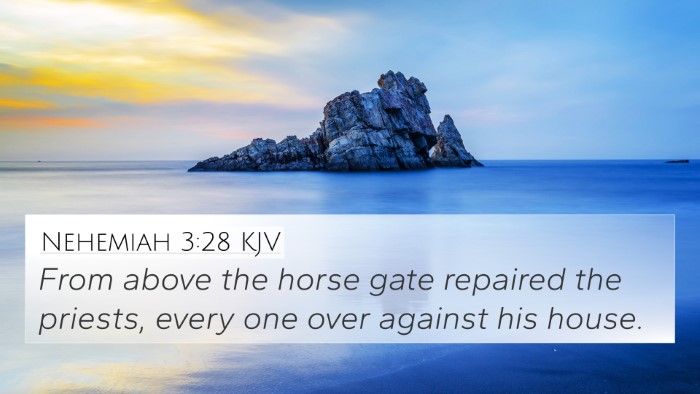Understanding Nehemiah 3:10
Verse: "And next unto them repaired Jedaiah the son of Harumaph, over against his house. And next unto him repaired Hattush the son of Hashabniah."
Summary of Meaning
This particular verse is set within the broader context of Nehemiah's account of the rebuilding of the wall of Jerusalem. In Nehemiah 3:10, we see a specific mention of individuals, Jedaiah and Hattush, who took personal responsibility for repairing the wall opposite their own homes. This reflected a deep understanding of community duty and the significance of each individual’s contribution to collective safety and restoration.
Commentary Insights
-
Matthew Henry's Commentary
Henry emphasizes the communal effort noted in this construction project, suggesting that the work of rebuilding the wall was not only a physical endeavor but also a spiritual one. Each builder's proximity to his own house symbolizes the personal investment that individuals must have in the health of their community. The mention of Jedaiah and Hattush indicates the importance of neighbors building together and supporting one another in their personal and communal undertakings.
-
Albert Barnes' Commentary
Barnes highlights how this verse illustrates the principle of individual responsibility within a community framework. He notes that the walls' repairs reflect the care that each person should have toward their own safety and the safety of those around them. It serves as an encouragement for others within the community to engage actively in endeavors that benefit the whole, thus drawing connections to the necessity of teamwork and unity in accomplishing communal goals.
-
Adam Clarke's Commentary
Clarke discusses the significance of names mentioned in this verse, suggesting that Jedaiah and Hattush were likely known figures within their community, representing wider societal efforts to restore what had been lost. Their work is a testament to their faith and dedication, showing that even mundane tasks, when performed faithfully, contribute to greater divine purposes. Clarke also underlines the lessons of participation and commitment to service within the covenant community.
Bible Verse Cross-References
This verse connects to several other Bible passages that underscore themes of community responsibility, cooperation, and the rebuilding of faith and structures. Below are relevant cross-references:
- Nehemiah 2:17: Nehemiah encourages the people to see the distress of Jerusalem and challenges them to rise and build.
- Romans 12:4-5: Paul describes how, like the body, each member has its role, underscoring the importance of individual contributions to the whole.
- 1 Corinthians 3:9: Paul refers to the church as God's field and building, a parallel to the reconstruction effort in Nehemiah.
- Galatians 6:2: "Bear one another's burdens," reflecting the communal aspect of supporting and building one another up.
- Hebrews 10:24-25: An exhortation to stir one another to love and good works, essential to community cohesion.
- Matthew 16:18: Jesus declares His intention to build His church, paralleling the intention to restore Jerusalem’s walls.
- Philippians 1:27: Paul urges believers to stand firm in one spirit, striving together for the faith of the gospel, much like the builders in Nehemiah's time.
- Ephesians 2:19-22: Describes believers as being built together into a dwelling place for God, emphasizing unity in purpose.
Exploring Connections Between Bible Verses
The narrative of Nehemiah illustrates significant connections between various scriptures regarding community effort, responsibility, and faith. From the Old Testament emphasis on rebuilding Jerusalem to the New Testament teachings about the church as a body, the principles highlighted in Nehemiah resonate through biblical history and reinforce the idea that individual contributions are essential to collective restoration and progress.
Tools for Bible Cross-Referencing
For those looking to delve deeper into cross-referencing biblical texts, various tools can assist in navigating these connections:
- Bible Concordance: A helpful resource for finding specific words or themes in scripture.
- Bible Cross-Reference Guide: Guides that provide connections between verses across the scriptures.
- Cross-Reference Bible Study: Methods for studying the relationships between various biblical texts.
How to Use Bible Cross-References
Using cross-references involves a systematic approach to understanding scriptural themes. By identifying relationships between verses, one can gain a deeper theological insight and a comprehensive understanding of the Bible's message. Here are a few methods:
- Identifying connections between Old and New Testament: Analyze how the themes of restoration in Nehemiah find parallels in New Testament teachings.
- Comparative study of Pauline epistles: Explore the unity of purpose and work within the church.
- Cross-referencing Psalms with New Testament teachings: Understand how prophetic words in the Psalms relate to the mission of the church.
Conclusion
Nehemiah 3:10 serves not only as a historical record but as a rich source of spiritual insight regarding community service, individual responsibility, and the importance of collective action in God's work. By employing various cross-referencing methods, individuals can uncover thematic connections that enrich their understanding of Scripture and encourage them in their personal and communal biblical journeys.





